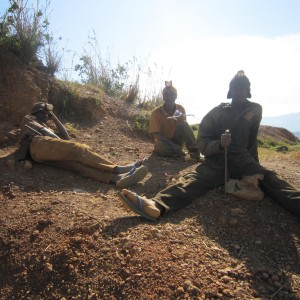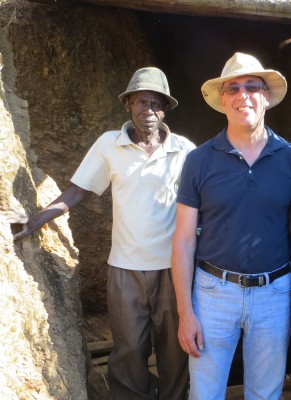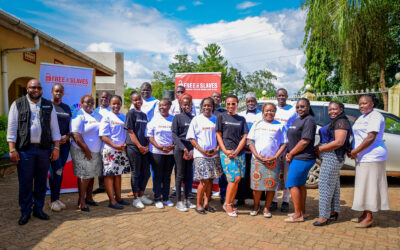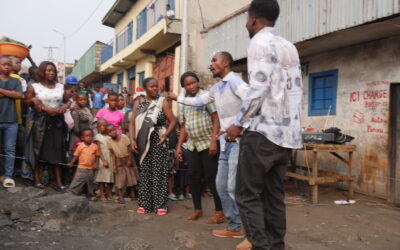Under the lush green hills and red clay that surround Lubono village, lies gold. It’s the centerpiece of the local economy. Much of the mining here is carried out by what are called “artisanal” miners. This term masks the incredibly difficult and dangerous work in which the miners are engaged.
The approach to mining here has more in common with the 19th century than the 21st. Using hand tools, shafts up to 30 meters deep and 100 meters lateral under the mountain are dug. The miners stop digging when the shaft becomes so deep that the air runs out (there are no compressors). The tunnels have little or no bracing, though they are watched carefully for fissures that signal the potential for a cave-in. The shafts do not even have ladders; the miners clamber up and down over rocks protruding from the sides.
The earth containing the ore is hauled out and then carried on the backs of the miners down the lengthy paths. The ore is crushed by hand and then washed in streams in search of flakes of gold. I struggled just to walk up and down the mountain; it’s hard to describe how physically grueling the work is in search of tiny amounts of gold that yield a meager living.
 The physical dangers are compounded by the risk of slavery. The miners work as small, independent teams of 5 to 10 people. The team leader will borrow money for tools and to pay living expenses until the mine begins to pay off, which doesn’t always happen. The miners fall behind in their obligations, which can lead to debt bondage slavery. The miners cooperative in this small community uncovered 61 cases of debt bondage. Other miners have been coerced into forced labor by thugs, soldiers and militias; 57 such cases were discovered, of which 40 were underage boys.
The physical dangers are compounded by the risk of slavery. The miners work as small, independent teams of 5 to 10 people. The team leader will borrow money for tools and to pay living expenses until the mine begins to pay off, which doesn’t always happen. The miners fall behind in their obligations, which can lead to debt bondage slavery. The miners cooperative in this small community uncovered 61 cases of debt bondage. Other miners have been coerced into forced labor by thugs, soldiers and militias; 57 such cases were discovered, of which 40 were underage boys.
While the great majority of miners are men, women in the surrounding community are also at risk, with cases of sex slavery and forced marriage reported.
I spoke to men and women who had been victimized by slavery. Laurent borrowed money for tools and food, accumulating a debt of over $1,500. The creditor threatened to take his home, tools and mine, ultimately leading to debt bondage. Matendo and Faida had both seen their husbands killed in the conflict that roiled eastern Congo and were then forced to marry their brothers-in-law according to local custom.
The leaders of the FTS Congo program – Jack Kahorha and Gabriel Deussom – have been working closely with a local NGO – Justice pour Tous, which means Justice for All – to build resistance to slavery in South Kivu. In Lubono, they have helped galvanize action by the miners cooperative. We met with the leaders of the committee in a clean, brick building they had constructed, with the leadership committee arrayed on wooden benches. The committee of 12 consists of nine men and three women, among whom are the traditional chief, the schoolteacher and the prefect of the local secondary school.
 Over the past year, they have carried out an amazing array of educational and organizing activities that are helping to prevent and end slavery in this mining community. These have included community meetings, home visits, public forums, educational sessions for children and youth in schools, small group discussions and training of teachers, clergy and village leaders. They worked with the local community radio station to develop a weekly broadcast on slavery that is heard every Sunday. They developed brochures that have been widely distributed in the surrounding area.
Over the past year, they have carried out an amazing array of educational and organizing activities that are helping to prevent and end slavery in this mining community. These have included community meetings, home visits, public forums, educational sessions for children and youth in schools, small group discussions and training of teachers, clergy and village leaders. They worked with the local community radio station to develop a weekly broadcast on slavery that is heard every Sunday. They developed brochures that have been widely distributed in the surrounding area.
Equally important has been the building of solidarity and joint action to confront slavery. Rather than being atomized, the community is finding protection by working together. To that end, they developed an action plan for identifying, liberating and supporting people who are enslaved. The cooperative intervenes in cases of debt bondage to negotiate the resolution of loans on reasonable terms. A savings and loan program has been started into which miners and their families are contributing small sums every Friday. The savings and loans meetings are also becoming a forum for social action, such as helping children who are out of school or malnourished. At-risk women, such as Matendo and Faida are coming under the committee’s protection.
The work of ending slavery in Lubono is far from finished. It remains an impoverished and at-risk community. But heartening progress in a very difficult context has been achieved. What lies ahead is the long-term, persistent work of strengthening community resources and organization so that the people of Lubono can protect themselves and live free.
Editor’s Note: Learn more about our work in the Congo on the FTS Congo webpage.


